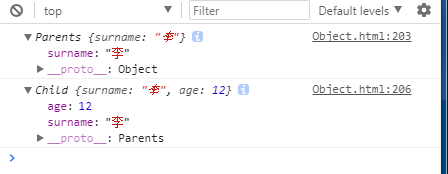js中的6中继承方式
oo语言支持两种继承:接口继承和实现继承,js中函数没有方法签名,所以只支持实现继承
1.原型链继承
实现思想:原型对象也是对象,将原型对象的prototype指向父类的原型(将父对象的实例赋给子对象的原型),即可实现继承
<script type="text/javascript">
//原型链实现继承
//父类
function Parents(){
this.surname='王';
this.getSurname=function(){
console.log(this.surname);
}
}
//子类
function Child(){
}
//将父类的实例赋给子类的原型,实现继承
Child.prototype=new Parents();
var c=new Child();
c.getSurname();
</script>
测试结果:

2.借用构造函数继承
实现思想:使用apply或者call()在子类的构造函数中执行父类的构造函数
<script type="text/javascript">
//借用构造函数
function Parents(){
this.surname='李';
this.getSurname=function(){
console.log(this.surname);
}
};
function Child(){
//执行父类的构造函数
Parents.call(this);
};
var c=new Child();
console.log(c);
</script>
测试结果:

3.组合继承
实现思想:使用原型链实现对原型属性和方法的继承,而通过构造函数来实现对实例属性的继承
<script type="text/javascript">
//组合继承
function Parents(surname){
this.surname='李';
}
Parents.prototype.getSurname=function(){
console.log(this.surname);
}
function Child(age){
//继承属性
Parents.call(this);
//自己特有的属性
this.age=age
}
//继承方法
Child.prototype=new Parents();
Child.prototype.constructor=Child;
Child.prototype.getAge=function(){
console.log(this.age);
}
var p=new Parents();
console.log(p)
var c=new Child(12);
console.log(c)
</script>
测试结果:

4.原型式继承:
实现思想:通过构建一个函数,参数为父对象,函数内部创建一个新对象,将父对象赋给新对象的原型,然后返回新对象。
<script type="text/javascript">
//原型式继承
//方式一
//传入一个对象
// function extend(o){
// function F(){};
// //将对象o赋给F的原型
// F.prototype=o;
// //返回F对象的实例
// return new F();
// }
// var parents={
// surname:'李',
// getSurname:function(){console.log(this.surname)}
// }
// //调用extend函数来实现继承
// var child=extend(parents);
// child.getSurname();
//方式二
var parents={
surname:'李',
getSurname:function(){
console.log(this.surname);
}
}
var child=Object.create(parents);
//定义子对象私有属性和方法
child.age=11;
child.getAge=function(){
console.log(this.age);
}
child.getSurname();
child.getAge();
</script>
5.寄生式继承
实现思想:创建一个仅用于封装继承过程的函数,该函数在内部以某种方式(创建子对象私有方法)来增强对象,最后再像真的是它做了所有工作一样返回对象
<script type="text/javascript">
//寄生式继承
function create(original){
//调用函数创建对象
var clone=Object.create(original);
//以某种方式增强对象(创建子对象私有方法)
clone.sayHi=function(){
console.log('hello');
}
return clone;
}
var parents={
surname:'李'
}
var child=create(parents);
console.log(child)
child.sayHi();
</script>
6.寄生组合式继承
实现思想:通过借用构造函数来继承属性,通过原型链的混成形式来继承方法(使用寄生式继承来继承父类的原型,然后将结果指定给子类的原型)。
<script type="text/javascript">
//寄生组合式继承
function inheritProto(parents,child){
var o=Object.create(parents.prototype);
o.constructor=child;
child.prototype=o;
}
//父类构造函数
function Parents(surname){
this.surname=surname;
}
Parents.prototype.getSurname=function(){
console.log(this.surname);
}
//子类构造函数
function Child(surname,age){
Parents.call(this,surname);
this.age=age;
}
inheritProto(Parents,Child);
Child.prototype.getAge=function(){
console.log(this.age);
}
</script>






